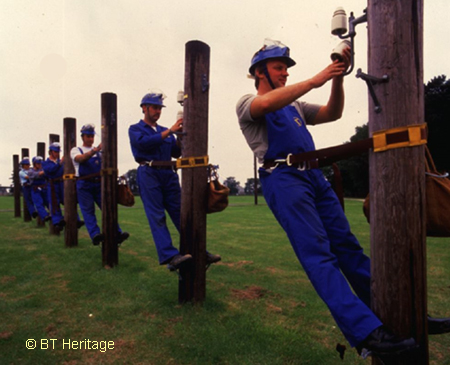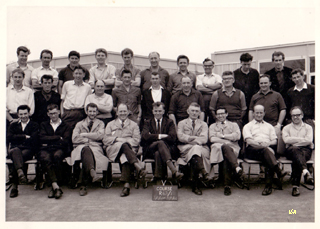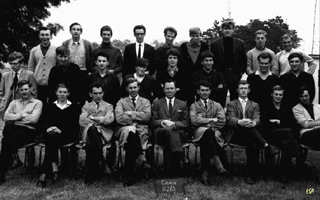 |
Trainee engineers, typically in their teens, attended a number of courses at the Home Counties, (Regional Training Centre) RTC Bletchley on the path to becoming a qualified Post Office Engineer. |
Introduction
In the Home Counties Region, it was proposed to set up a residential Training School for all sections of Post Office Personnel. Bletchley, with its central location was ideally suited to the requirements of the Post Office, which at that time was still a Government department. Thus in 1948, the local training centres began to transfer to the Park.
| Date | Section | Transferred from |
| 1948 | Postal Sections | Bedford, Guildford, Lewes, Luton, Norwich, Portsmouth and Slough |
| 1948 | Clerical Section | Bedford |
| 1949 | Internal Engineering | Brentwood and Cambridge |
| 1949 | Counter & Writing Sections | Norwich and Oxford |
| 1949 | Telegraph Regional Schools | Cambridge, Guildford, Oxford and Reading |
| 1952 | External Engineering | Hurley |
| 1953 | National Drawing Office Courses | Harrogate |
| 1954 | Jointing Section | Brentwood |
| 1954 | Overhead Section | Hurley |
| 1955 | Internal Section | Cambridge |
Thus, by 1965 courses were running throughout the year for the five main sections of the Post Office:
|
|
Engineering Courses
Youth A and TTA (Trainee Technician Apprentice) and TO (Technical Officer) gave way to terms such as YIT - Youth In Training and TOIT - TO In Training.
Brian Hembling
Brian W Hembling attended courses at the Bletchley PORTC.
 |
Brian Hembling had a long career with the GPO... |
Bruce Lloyd attended course R2/3 at Bletchley PORTC between 17th May and 9th July 1965.
 |
Bruce writes, "I did the Youth in Training courses and I mainly remember the telephonists or telegraph operators being trained there..." |
George (Paddy) Thompson attended the R10/4 Fitting Course at Bletchley PORTC between 01/10/1962 and 19/10/1962.
 |
Dawn writes, "My Dad George (aka Paddy) Thompson is fourth from the left in the middle row wearing a tie." |
Bob Oborne writes...
Not all GPO telephone engineers started as apprentices (Youths in Training). The increased demand for telephones in the 1960s, together with the conversion programme from manual to automatic exchange working throughout the land, and the projected work in rearranging the switched network for Subscriber Trunk Dialling, gave rise to more adult recruitment in the engineering field during this decade. I was one such adult entrant in 1964 after answering an advert in the local paper, and subsequently starting on Internal Works (Exchange Construction) at Dorking ATE in Surrey around three months later with virtually no knowledge of the public telephone system.
I received about half the wages (£11 5s 0d per week as a T2B) than from my previous factory job. The work however, as expected, was more interesting with more prospects and generally cleaner. At that time I was twenty two, unmarried and had now become a civil servant with more security for the future if I made the effort. I was not the only beginner to join the construction team that month and fortunately the technical officer with whom I started was a calm Liverpudlian who took the time to teach his new charges how the system worked and the practices involved. Ray had a great sense of humour, which he certainly now needed. Inevitably we made mistakes, but, after a moment of initial panic, he took them all in his stride. There was much to learn. As new recruits we attended practical training sessions at Guildford and a specially tailored fortnight long course at Bletchley Park to bring us up to speed with the way things should really be done. Back in the area, once regarded as half way competent, advancement came to T2A. The City and Guilds examinations for a Telecomms Technicians Certificate were tackled in our own time. Unlike apprentices there was no day release to college for us.
The telephone exchange at Dorking consisted of two stories above the post office and sorting office in the High Street and comprised an apparatus room with an auto-manual operators' switchboard on the top floor. In the basement was the cable chamber. There was no yard as such, only a loading bay for the postal vans. A strowger equipment room could be quiet in the early morning with mechanical noise rising to a crescendo around 10 a.m. during the "busy hour." Exchange equipment faults were detected by experienced maintenance TOs often by just listening to the equipment further up the apparatus room as it stepped and hunted. The basic test equipment for the "faultsmen" who worked outside, was the Detector No.4, a sturdy voltmeter that still worked after it had been dropped from the top of a pole. The older men however licked their finger and thumb, placing them across a pair to detect the necessary voltage on the line and hoping it was not being rung at the time.
Dorking was the parent exchange of the Newdigate Call Charge Area (so designated as that particular small village was the centre of telephone density for Dorking and its group of dependant exchanges). The parent, dating from 1936, contained a mix of Pre-2000 and 2000 type switching equipment, including the original Pre-2000 linefinder groups, all housed on apparatus racks, many of which were fed by the original waxed silk and wool insulated cables with black enamelled conductors and braided cable sheaths impregnated with asbestos. With ingrained dust in the wax, it was now impossible to tell the colour of the insulation on any of the wire terminations from these old cables, as they had now all turned black. The old Pre-2000 selector bank wiring was brittle, but some spare positions, fitted nearly thirty years before, were brought into service with re-used switches recovered from other exchanges up country. The engineers who had taken them out in distant areas probably thought they were to be thrown away. Any new cabling was of course now carried out using the modern light straw PVC cables, but all connections were still cut, stripped, terminated and soldered. There were also some earlier PVC cables with battleship grey sheathings. The wire wrapping gun had not quite yet made an appearance, and insulation displacement connectors for cabling came years later. New equipment from the GPO stores was still appearing in light battleship grey, with some arriving in light straw. Any new equipment provided by the manufacturer's contract installers was all in light straw. In our work we sometimes fabricated miscellaneous equipment racks from angled steel that had been cut to size by the regional workshops and fitted new cable racking. If the surrounding equipment, as well as that to be fitted, was all battleship grey, then we painted the iron work and new cable racking that colour also. If it was light straw, then naturally we used light straw paint to match. The main internal cable holes were filled with the original packs of blue asbestos to retard fire, and a white asbestos covering board used. The reportedly more effective vermiculite mineral however was used for all new work or resealing existing holes after our cabling was complete.
The dependant exchanges around were mostly also old. They consisted of a discriminator satellite, a Pre-2000 UAX7, several 2000 type UAX13 exchanges, two of which were not too old, being all in PVC wiring and with open racks. One of these newer UAX13s was in the former village hall, the building having been purchased by the GPO. There was more than enough floor space for extensions. Another relatively modern UAX13 was originally in the London South Telephone Area, but now inherited by Guildford. The remaining two UAX13s had the closed cabinet type racks, although the doors had been discarded and thermo-tubes fitted in the bottom to provide heating in place of the previous inbuilt system. The other two dependants were manuals. The oldest of these was a two position local battery signalling board with doll's eye indicators, located in the back room of the village butcher's shop. Its main distribution frame was near a fireplace that contained an open fire in the winter to keep the two operators warm. Here they may tell an incoming caller that it wasn't worth ringing now as the person they were trying to reach was out shopping. The other manual exchange was slightly larger (probably a CB10) being in its own dedicated building, although a similar personal service was also given.
This then was the charge group on which STD was be provided in the next few years. Of these exchanges, the parent was completely replaced in a new building, becoming the GSC; the discriminator satellite converted to group selector satellite working; the UAX7 replaced with a TXE2; the old manual in the butcher's shop absorbed into the parent by external cable development; the other manual temporarily replaced early with two MNDX and one MTX units before being permanently replaced with a TXE2; one UAX13 replaced with an SAX; another replaced with a similar UAX13 in a new building, leaving the two remaining UAX13s and the new one to be converted to STD working. Although I worked all over the Guildford Telephone Area at various times on many types of equipment, Dorking was my home exchange and I spent much of the next fifteen years working in its charge group, mostly as an internal works TO until moving into the planning office with the prospect of an A/EEs board.
Andy Reynolds
Andy Reynolds recalls...
I served one of the last true apprenticeships in 82 and ended up a Special Fault Investigator covering all the UAXs and subs apps. around Stevenage and Hitchin. All the smaller sites were Strowger, larger ones being Crossbar. I served my apprentice a,b,c, subs apps. and relay adjustment courses at Bletchley, staying in the wonderful Gifford House (One of the big H blocks). We had a barrack room each to sleep in with a sink in one corner and a wardrobe in the other. WE did our pole training in a shed at the bottom corner by all the aerials.
All logos and trade marks are the property of their respective owners and are used on the Light Straw site(s) for review only. Students and researchers are recommended to make their own independent enquiries as to the accuracy of the information contained therein.